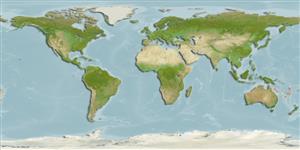Klassifizierung / Names
Namen | Synonyme | Catalog of Fishes(Gattung, Arten) | ITIS | CoL | WoRMS | Cloffa
>
Pleuronectiformes (Flatfishes) >
Samaridae (Crested flounders)
Etymology: multiradiatus: Name from Latin 'multus' for numerous and 'radius' for rays, referring to the many dorsal and anal fin rays.
(meaning numerous) and radius (rays)..
Environment: milieu / climate zone / depth range / distribution range
Ökologie
seewasser bathydemersal; tiefenbereich 296 - 430 m (Ref. 74925). Deep-water
Western Pacific: New Caledonia.
Size / Gewicht / Alter
Maturity: Lm ? range ? - ? cm
Max length : 6.1 cm SL Männchen/unbestimmt; (Ref. 74925)
Kurzbeschreibung
Bestimmungsschlüssel | Morphologie | Morphometrie
Rückenflossenweichstrahlen (insgesamt) : 85 - 91; Afterflossenweichstrahlen: 67 - 72; Wirbelzahl: 34 - 35. This species is distinguished by having the following set of character states: dorsal fin rays 85-91; anal fin rays 67-72; pectoral fin rays 5, vertebra, 9 abdominal and 34-35 caudal (Ref. 74925).
Life cycle and mating behavior
Maturities | Fortpflanzung | Spawnings | Egg(s) | Fecundities | Larven
Kawai, T., K. Amaoka and B. Séret, 2008. Samariscus multiradiatus, a new dextral flounder (P;euronectiformes: Samaridae) from New Caledonia. Ichthyol. Res. 55:17-21. (Ref. 74925)
IUCN Rote Liste Status (Ref. 130435)
Bedrohung für Menschen
Harmless
Nutzung durch Menschen
Tools
Zusatzinformationen
Download XML
Internet Quellen
Estimates based on models
Preferred temperature (Ref.
123201): 7 - 17.4, mean 13 °C (based on 20 cells).
Phylogenetic diversity index (Ref.
82804): PD
50 = 0.5000 [Uniqueness, from 0.5 = low to 2.0 = high].
Bayesian length-weight: a=0.01622 (0.00604 - 0.04358), b=2.94 (2.71 - 3.17), in cm total length, based on LWR estimates for this (Sub)family-body shape (Ref.
93245).
Trophic level (Ref.
69278): 3.4 ±0.4 se; based on size and trophs of closest relatives
Fishing Vulnerability (Ref.
59153): Low vulnerability (10 of 100).
